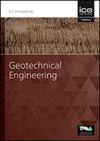Experimental investigation on the deformation coordination between an optical fibre and backfilling sand of borehole
IF 1.7
4区 工程技术
Q3 ENGINEERING, GEOLOGICAL
Proceedings of the Institution of Civil Engineers-Geotechnical Engineering
Pub Date : 2023-08-03
DOI:10.1680/jgeen.23.00055
引用次数: 0
Abstract
Land subsidence has threatened the safety of municipal infrastructures and even that of inhabitants. As one of the deformation monitoring methods, distributed optical fibre sensing (DOFS) technology has been developed for the investigation of land subsidence. The deformation coordination between the optical fibre and soil (DCf-s) under different conditions is critical for land subsidence monitoring with DOFS. In this paper, a medium-size triaxial apparatus was modified for testing the DCf-s. Consolidated drained triaxial tests were conducted to investigate the effect of sand types on the DCf-s. By linearly fitting of the deformation of the sensing cable with that of the triaxial specimen, the other factors that affect the DCf-s, such as the confining pressure, dry or wet state of the soil, and cyclic variation of the loads, were discussed. The experiments reveal that better DCf-s comes with a larger particle size, poor gradation of sand, and larger confining pressure. The DCf-s of wet sand is better than that of dry sand. The DCf-s coefficient tends to be stable with increasing of loading cycles. The obtained DCf-s and its dependence on influencing factors can be used to modify the measured cable strain in practical land subsidence monitoring with DOFS.光纤与钻孔回填砂变形协调试验研究
地面沉降已经威胁到市政基础设施甚至居民的安全。分布式光纤传感(DOFS)技术作为变形监测方法之一,已发展成为地面沉降监测的重要手段。光纤与土体在不同条件下的变形协调是进行地面沉降监测的关键。本文对一台中型三轴仪进行了改进,用于测试DCf-s。采用固结排水三轴试验研究了不同砂型对DCf-s的影响。通过对传感索的变形与三轴试件的变形进行线性拟合,讨论了围压、土的干、湿状态以及荷载的循环变化等因素对DCf-s的影响。实验表明,较好的DCf-s伴随着较大的粒径、较差的砂级配和较大的围压。湿砂的DCf-s优于干砂。随着加载次数的增加,DCf-s系数趋于稳定。得到的dfs -s及其对影响因素的依赖关系可用于实际地面沉降监测中对实测索应变的修正。
本文章由计算机程序翻译,如有差异,请以英文原文为准。
求助全文
约1分钟内获得全文
求助全文
来源期刊
CiteScore
4.40
自引率
4.50%
发文量
68
审稿时长
3 months
期刊介绍:
Geotechnical Engineering provides a forum for the publication of high quality, topical and relevant technical papers covering all aspects of geotechnical research, design, construction and performance. The journal aims to be of interest to those civil, structural or geotechnical engineering practitioners wishing to develop a greater understanding of the influence of geotechnics on the built environment.

 求助内容:
求助内容: 应助结果提醒方式:
应助结果提醒方式:


